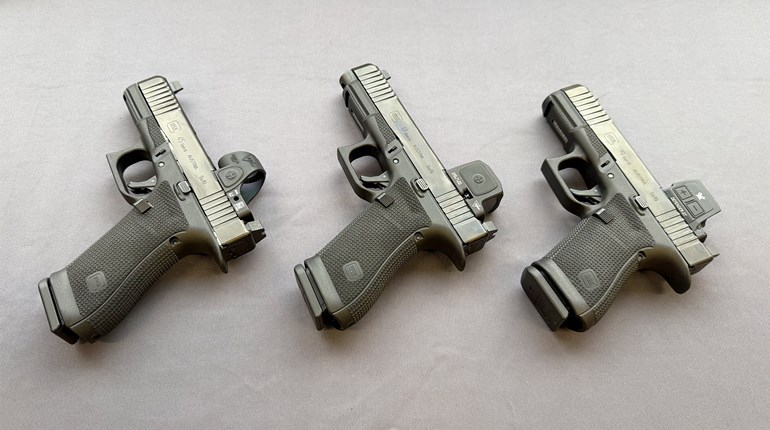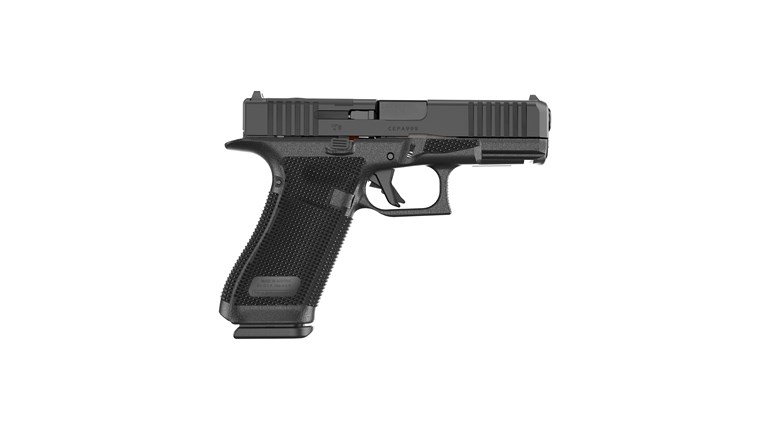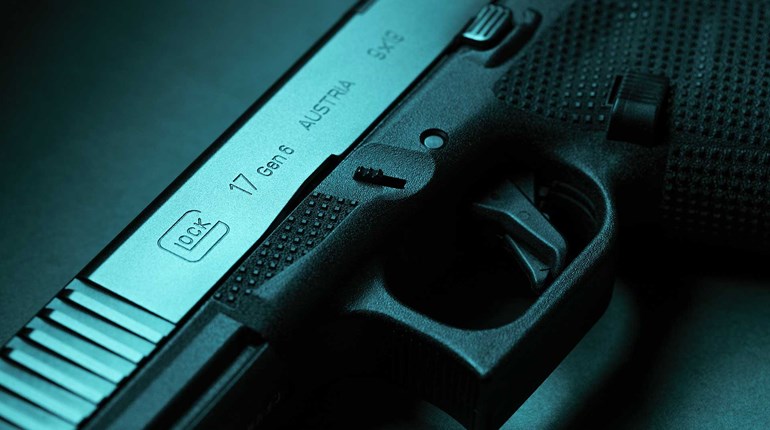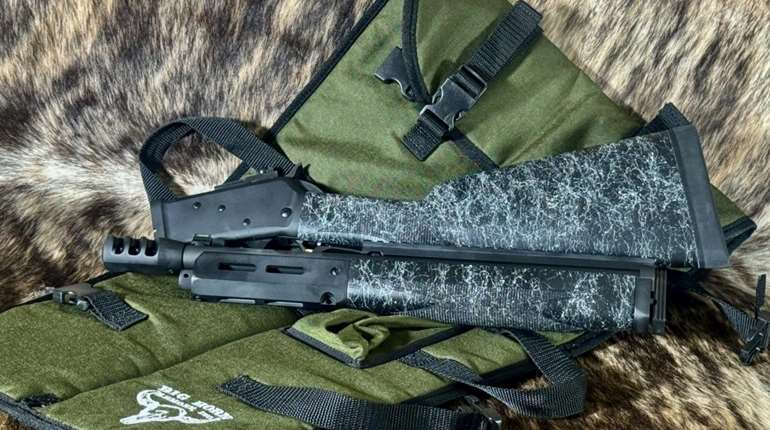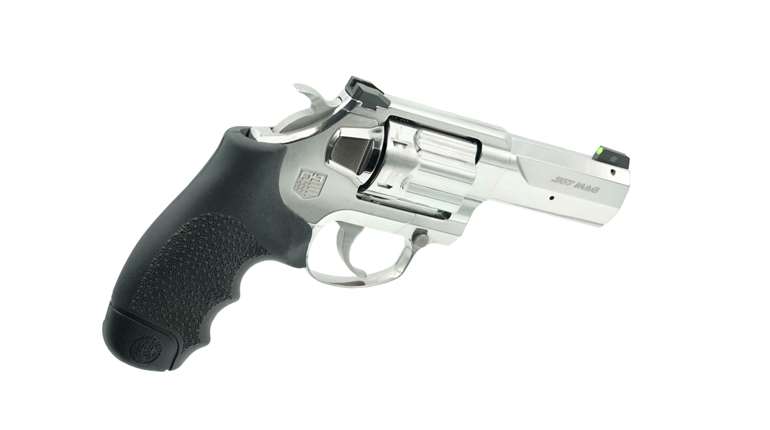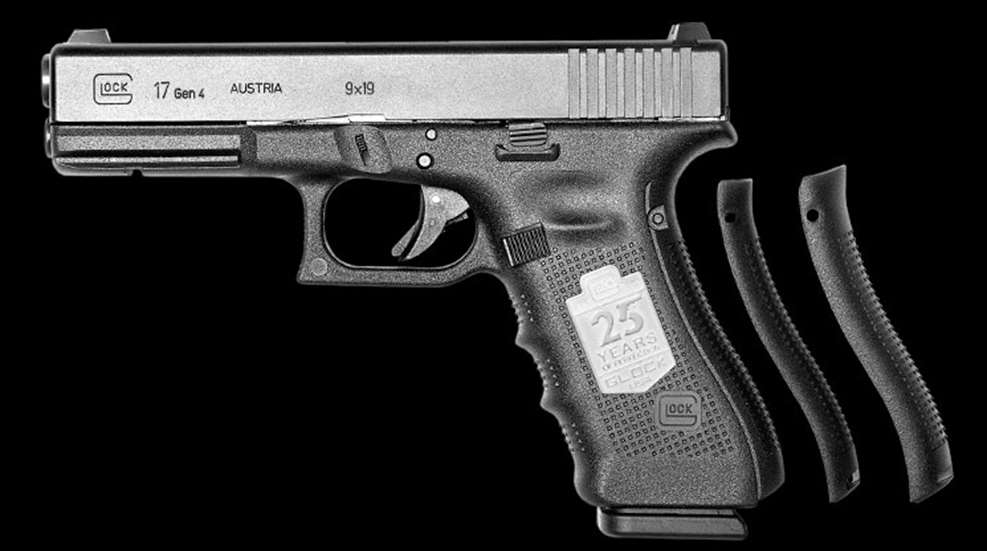
In the early 1960s, Glock was a manufacturer of small plastic and metal parts in Austria. Twenty years later, with no history of manufacturing firearms, the company won a contract with the Austrian military and delivered 4,000 handguns to that nation's army. Recognizing where the real-world market for handguns was, the company sent its G17 pistol to ATF in the mid-80s for approval to sell the gun in the United States. In 1986, Glock shipped its first pistols to our shores for commercial sales. For Americans, that year marks the beginning of Glock's incredible 25 years reshaping our vision of a defensive handgun. For the world, it redefined the standards of law enforcement handguns from all-metal pistols with some kind of hammer to striker-fired, polymer weapons. To prove it wasn't a fluke or just a passing fad, Glock has manufactured and sold more than 7 million handguns over that 25-year period.
Buz Mills of Gunsite Academy decided to do something to celebrate the milestone. Many of Gunsite's students, both civilians and law enforcement personnel, train at the Academy with Glock pistols. I hesitate to call these folks fanatics or cultists, but they are an enthusiastic bunch who loudly praise their chosen pistol for its simplicity and utter reliability. With little lead-time until year's end, Mills sent out his newsletter announcing Gunsite would conduct a 250 Defensive Pistol class in early October exclusively for Glock pistols in celebration of the company's silver anniversary. In no time, he had two full classes of students committed and eager to attend. Ever the gun-writer pest, I made a couple of phone calls and got myself invited.
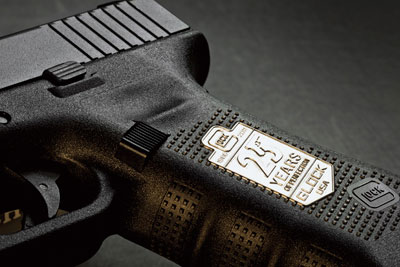
Truth be told, I have never been a member of the Glock community. I have greatly admired the pistol's simplicity and documented reliability, but the first few generations of pistols never felt right, or to say it differently, the guns just didn't fit me. When some respected friends recently suggested I might like the company's Gen4 pistols and Gunsite announced the Glock 250 class, my non-rocket-scientist brain put two and two together, which for me added up to 250.
If you're not familiar with the Gunsite curriculum, the original Jeff Cooper experience is the 250 class, and it encompasses five days of supervised training including 1,000 rounds of ammo plus another 50 to 100 rounds of frangible ammo for exercises in the fun house and outdoor wash. I cannot think of a better way to objectively test a pistol and one's personal skills than in a five-day defensive-pistol class under the watchful eye of the Gunsite training staff with their diversified backgrounds. They also take great glee in humbling any overinflated ego.
My rules were simple. First, test the Glock's legendary reliability. Second, run a Gen4 pistol for five days straight and determine at what point in the week it began to feel right and when I felt competent in using the pistol to defend my life.
The first test was simple: I removed the G19 and three standard-capacity magazines (15-round capacity is standard, 10-round is reduced or "California") from the box and ran the hardware for the entire week with absolutely no maintenance. I applied no lubrication, nor did I disassemble or clean the gun at any time. I didn't even wipe the gun's exterior off except a couple times after I slopped sunscreen all over my face. As you might expect, the gun acquired some lotion from my hands and became a little slippery in the warm afternoons. Wiping my hands usually cured the problem, but there were a couple of times where I had to wipe off the grip.
Somewhere between 350 and 550 rounds (considered by some experts as a reasonable break-in period for a pistol), there were three failures to feed, all of which were resolved with the standard tap, rack procedure. Somewhere around 800 rounds, there was one more failure to feed, but it too cleared with a tap, rack. Nor was this record achieved with just 115-grain ball ammunition. The G19 also digested Hornady's new jacketed-hollow-point match ammo with steel cases and an additional 60 rounds or so of the aforementioned frangible ammunition. Accuracy remained outstanding throughout the week, with head shots being made regularly at 15 yards and skinny poppers being taken down at ranges around 35 yards. I was very impressed.
Regarding my second rule, I had borrowed a 4-inch-barreled G19 along with a plastic, straight-drop Blade-Tech holster. Upon first handling the gun, I realized I could comfortably reach and control the trigger without compromising my grip, even though the G19 is a wide-body handgun utilizing double-stack magazines. This is attributable to three grip inserts that ship with the pistol. The small size was on the gun as delivered, and I never considered changing it.
I'm not saying the trigger is like a 1911—it's not. In fact, it's heavier than a good 1911, but the pull is extremely consistent and has a great reset that can be verified both audibly and by touch. I doubt you'd hear it reset in an actual gunfight, but our coaches could hear it on the line and issue instructions to students accordingly. Regardless of background noise, you can definitely feel the trigger reposition itself for the next shot. I like light triggers for precise, long-range shots, but for close-in, fast shooting, a little extra weight is a good thing.
One of my original "doesn't fit" critiques of Glocks dealt with the grip-to-barrel angle. The gun always seemed to be pointing high when I extended my arms to shoot. The front sight was always considerably higher than the rear sight, and I could see the entire top of the slide. Obviously, in the course of shooting 1,000 rounds in a week, one can adjust to this perspective, but more than that, I discovered a real advantage when coming from the holster for close-in, rapidly delivered shots. As the gun is extended to the firing position, the large front-sight blade with the white dot stands out like an airplane on the end of an aircraft carrier's flight deck. It's impossible not to see it. Your eye picks it up as the gun moves toward the threat, and you begin your trigger squeeze as the dot begins to cover the target's chest or head. I know professional shooters are blindingly quick at putting the front sight on steel as part of their draw stroke and during transition from target to target, but I've always been terribly slow in making the transition from eyes on target to eyes on front sight to front sight on target. The Glock's flat "carrier deck" helped me to get properly focused and on target more quickly than I've been able to do in the past, and I suspect this would prove equally true for shooters concerned with self-defense who don't practice as much as Rob Leatham or Jerry Miculek.
Many of today's defensive-oriented pistols (and Glock is certainly a member of that family) come with the three-white-dot sight system; two on the vertical sides of the rear sight and one on the front-sight blade. Many knowledgeable shooters believe the dots on the rear sight are superfluous. For close-in shooting, simply put the front dot on the target and press the trigger. For longer-range shots, some shooters tend to align the three dots side-by-side, which can cause a problem if the dots aren't precisely placed. Due to the white outline on the G19's rear sight, you can slide the white front blade into the three-sided rear-sight box quickly, with no tendency to align anything. It seemed faster for close shots, while allowing the classic sight picture required for precision shooting at longer ranges.
The Glock is also known for having all internal safeties with nothing on the outside of the handgun to manipulate. For new shooters, simpler is better. You still need a proper shooting grip at the beginning of the draw stroke, but you don't have to deal with an external safety as part of the maneuver. The higher capacity of the Glock compared to my beloved, single-stack 1911 also required some adjustment on my part. I can keep track of rounds expended in a 1911 because I'm only counting in single digits (it's that rocket-scientist thing again). In the Gunsite exercises, one is always responsible for ammunition management, which means tactical reloads are expected before the gun is run dry. My adjustment was to reload when I was at a point where I would have depleted an 8-round 1911 magazine, thereby leaving the equivalent of a full 1911 load in the mag I had removed and stored. As you would expect, that kind of capacity is greatly appreciated, even in a simulated gunfight. Fully loaded and with two spare magazines, the G19 carries almost a full box of ammunition.
Glock's fantastic success is not difficult to understand. It was the right product presented at the right time for the right mission. I am not ready to surrender my 1911; it is a great fighting handgun and has been for 100 years. But while the 1911 stirs my soul, the Gen4 Glock stirs my survival instincts. Nobody gets out of this life alive, but if you want to extend your stay here as long as possible, attend a Gunsite defensive pistol class. And if you want to become competent quickly, take the class with aGen4 Glock.












